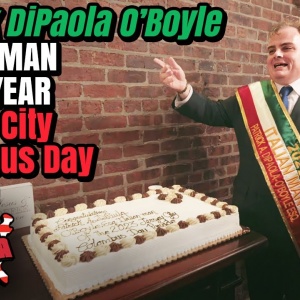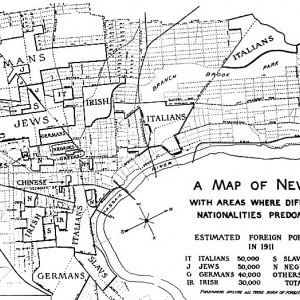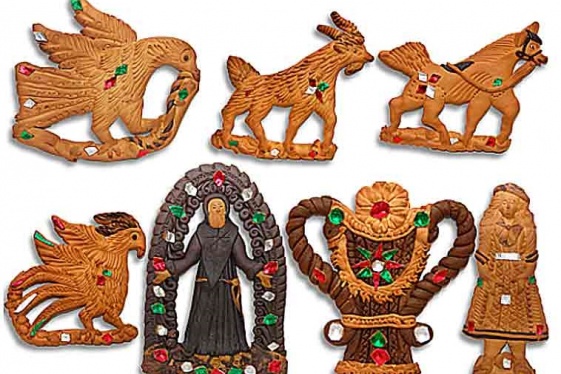
Andrea Cammarato-Van Benschoten (Author of the book "Italians of Newark: A History")
La storia degli italiani a Newark, raccontata da una ragazza del New Jersey con radici italiane

Until a few years ago there were ten Italian Consulates in the United States, because there was also one in New Jersey, in Newark. It was a very bad choice to close it ten years ago, in my opinion, because the area is very populated with Italians and Italian Americans, and the two Consulates in New York and Philadelphia, which had to share the responsibilities of the one that was closed, were already overworked.
But what is the history of Italians in Newark? This is covered in a fine book that has just come out, written by an Italian American who is proud of her origins, Andrea Cammarato-Van Benschoten, who takes us on a journey of discovery of Italian-ness in this part of the Garden State.
https://podcasters.spotify.com/pod/show/umberto-mucci1/episodes/Italians-of-Newark-A-History-told-by-a-Jersey-Girl-with-Italian-roots-e2pduca
Hi Andrea, welcome to We the Italians. Please tell us something about your Italian roots
Thank you very much Umberto. And thank you for being such a wonderful advocate for the Italian American community!
The first in my family to reach the United States was my great-grandfather, Gabriele Ficetola, documented as Gabriel E. Fucetola when he arrived at Ellis Island in 1888. He was born in Calabritto in 1856. He and his wife, Lucia, made their home together in the First Ward of Newark. My other set of great-grandparents on my mother’s side, Ettore Victor and Rosaria Fieramosca, arrived in 1899 and also made their home in the First Ward. On my father’s side of the family, my great-grandparents, Michele and Angelina Palmieri, also immigrated from Calabritto. My fourth set of great-grandparents, Santo and Concetta Cammarato immigrated from Sicily. They all settled in the Old First Ward of Newark. An area a little less than one square mile but grew to be the largest Little Italy in New Jersey.
After opening your blog “Jersey Girl, Italian Roots”, you are about to publish your first book: “Italians of Newark”, with a foreword of my dear friend Patrick A. O’Boyle, Esq. Please tell us about the blog and the book…
Pat has been a huge point of support for me throughout the process. We immediately connected as fellow North Jerseyans. It turns out we grew up only a few towns away from each other. His stories of the special relationship he had with his grandmother really reminded me of the love and admiration I have always had for my grandmother. She was a huge inspiration for me. I asked him to write the forward and I was incredibly grateful when he agreed.
My first blog was originally about my beloved state of New Jersey. I started it to fight the negative stereotypes that developed when the shows Jersey Shore and Real Housewives of New Jersey hit the airwaves. As I continued to write, I found myself writing more and more about my Italian heritage and the important role it played in my upbringing. New Jersey has always been a state with strong Italian-American communities.
That combination of Italian heritage coupled with New Jersey pride makes for a unique combination. That brought me to create a completely separate blog focused on my heritage called Jersey Girl Italian Roots. I share stories about growing up as an American of Italian descent and how our community has evolved in New Jersey. I write not just about my family, but the other important achievements our community has made to our state as well as our entire country. I feel it is important to share all the positive contributions of our community as well as fighting the negative stereotypes you often see in American media.
The first chapter of the book is about “The History of the Great Migration 1880-1920”
I wanted to really take a look at the “why” behind this mass migration. Why would millions of people living in the same communities and villages for generations take such a huge risk and leave all they loved and knew behind? Many of them never saw their loved ones again. As someone who has trouble moving from one town or county to another, I live about an hour away from where I was born and grew up, I can’t imagine moving to an entirely new country with almost no money, no language skills, and rarely any formal education. These immigrants did not just survive but thrived. Theirs is a story of grit and determination that is to be admired and deserves to be told.
Then the book talks about “Discrimination against “I”-talians and Americanization”
As I continued my research, I began to learn the depths of discrimination Italian immigrants encountered when they arrived. It left me feeling both frustrated and sad. From the pejorative terms that were used to describe them, to the stereotype of a Mafia connection that was associated with every Italian immigrant, to the treatment they received during World War II, it is amazing they were able to overcome so many challenges. I admire their fortitude even more after learning so much about what they faced.
The federal government with support from special interest groups were successfully able to pass legislation several times to greatly curtail the influx of Italian immigrants. In the mid-1920s, the spigot was almost completely turned off – and kept that way – until the mid-1960s.
One story I learned about in my own family was the treatment of my great-grandmother, Concetta Zinna-Cammarato, who was required to register as an Alien of Enemy Nationality. An illiterate woman who never held a job and never moved out of the First Ward of Newark, was interviewed multiple times during and after World War II in search of ties to the enemy in Italy, of which she had none. I was able to attain this information through a request for her immigration file from the National Archives Immigration Database. In addition to receiving her registration file, I received another document that was dated several years later when she was investigated again. This time for moving without notifying the Department of Justice’s Immigration and Naturalization Service of the planned move. She moved just a few blocks over, still within the neighborhood of the First Ward. She was fingerprinted and her photo taken. That headshot is the only photo I have ever seen of her. I can’t tell you how long I stared at that grainy photograph and trying to think about what must have been going through her mind. Her son, my great-uncle Anthony, accompanied her on every appointment and had to sign for her, as she couldn’t even sign her own name. Next to his signature would only be a cross with the notation “her mark.” I just can’t imagine how it affected her. My heart just broke as I learned about her story and how thousands of immigrants just like her were treated.
Three chapters of your book are about “The Neighborhood: The Old First Ward, The Ironbound/Down Neck, Other Italian Immigrant Communities in Newark”
While the Old First Ward was the largest Little Italy in Newark, as well as all of New Jersey, there were several other Italian immigrant neighborhoods within the city’s border. For example, the Ironbound, also known as “Down Neck,” was initially settled around River and Mulberry Streets. However, this neighborhood suffered the same fate as the First Ward and the Italian immigrants were displaced to eminent domain in order to build Penn Station. They eventually found their way toward Ferry Street. That enclave remained in place for several decades.
Another Italian immigration neighborhood developed in the 14th Ward of Newark and grew large enough to require its own church. Unfortunately, just as the other Italian neighborhoods were displaced, the 14th Ward Italian neighborhood suffered a great tragedy when 14 members of the community were killed in a fire.
What about the “Information for the Community: Newspapers”?
The Italian communities of Newark were very lucky to have a few strong sources of news and information for an extended period of time, including Il Progresso Italo-Americano and The Italian Tribune. I remember seeing them for sale at the bakery on Sundays. I still get The Italian Tribune, even though I get it delivered now.
The last three chapters of the book are about three very fundamental topics of every Italian enclave in the US. Please tell us about “The Role of Social Clubs and Mutual Aid Societies”
Social clubs and mutual aid societies were crucial for newly arrived Italian immigrants. They not only provided a place for camaraderie, playing bocce, cards, and even American baseball, they provided important financial and social support for those struggling with health issues, loss of work, and even death benefits. My Uncles belonged to the Tacoma Club and all enjoyed playing cards there. We grew up hearing a story about a member of our family who had two bands when she passed away because she belonged to multiple societies. They were often focused around the neighborhood’s church, as well as the villages they emigrated from in Italy. Of all of them, almost none remain today. The Spilingese Social Club remains an active organization in the Ironbound, just down the street of Our Lady of Mount Carmel.
I guess that “The Importance of Family and Food” was not small in the Italian American community of Newark, am I right?
It was an absolutely huge part of the community. Everyone I spoke with for the book had a story about Sunday dinner, a holiday meal, or cooking with grandma. These were some of their most powerful memories. Many of the favorite dishes were often the simplest meals with inexpensive ingredients. We had no idea they were not considered authentic Italian dishes. We just knew our grandmother or mother made them for us with love and they hold a special place in everyone’s hearts. I know of no Italian American kid that didn’t get pastina made by grandma when they were sick. Many would joke and call is “Italian penicillin!”
The other common theme when it came to food was the lack of documented recipes. When those immigrants came to America, they simply adapted their original simple meals to the new ingredients available to them. So when a son or daughter wanted to learn a recipe, it was always a challenge. The concept of “one cup” or “two teaspoons” didn’t exist. You do your best and begin to write down what grandma was doing. You try to discern exactly what “a handful of flour” equates to in terms of cups. Then half-way through the process, she decides to add “a little more flour.” Well, exactly how does that “little more” plus the original “handful” total? There was always a bit of approximation. What I decided to do was document some of my most favorite recipes I grew up enjoying and I have shared them in the book; as best as possible that is.
Last but not least, “The Role of the Church”
This chapter required the most research and time. It was incredibly important to me that I document as much as possible and that all the information was accurate. I grew up going to St. Lucy’s in the Old First Ward for the Feast of St. Gerard and knew of Our Lady of Mount Carmel in the Ironbound. However, there were other churches specifically for the Italian community. Each church represented the heart of its neighborhood in Newark. Sadly, several of these special places are no longer in existence. I also learned about the lack of acceptance Italian immigrants faced when they first arrived. I had heard the term “basement Catholics” periodically when I was younger, however, I never knew it was literally how Italian immigrants were treated. They were relegated to the basements of the established Catholic parishes. Their form of worship was not acceptable to the Catholic Church establishment. However, they did not give up on their celebration of patron saints and feats. It took time for these immigrant communities gain acceptance and receive the spiritual support they needed.
Mother Cabrini also played a key role caring for the children in the Ironbound where she established the first school for the children of Italian immigrants. She was able to expand the school and educate hundreds of children. Unfortunately, the property was commandeered to build what is now known as Penn Station. But her legacy and a strong devotion to her remains in the Ironbound at Our Lady of Mount Carmel.
Almost every weekend from spring to fall, there was some kind of feast taking place in one of the Italian neighborhoods and they lasted for days. For example, many told me about the “flight of the angels” during the Feast of St. Michael, where little girls dressed as angels were pulled on ropes high above the street as St. Michael passed. The two feasts that remain are Our Lady of Mount Carmel in July and the Feast of St. Gerard at St. Lucy’s in October.
The three themes that I identified throughout my research were faith, family, and food. And it was at the feasts all three of those themes came together. All the research I did really gave me a deeper sense of faith and an even greater appreciation for all my ancestors endured so that I can live the life I have today. I am keenly aware I stand on their shoulders and do my best to honor them every day. I was taught at an early age to “never forget where you came from.” To recognize I am an American first, but my heritage continues to play a vital role in who I am. I can’t even put into words the respect I have for this community and the opportunities it has afforded the descendants of those original immigrants that arrived here 100 years ago with nothing more than a few dollars in their pocket, their faith, and a willingness to work hard. Everything was against them, yet they became a thriving and successful community. I can only hope to carry on as best I can in their honor.
You may be interested
-
“The Hill” St. Louis’ Little Italy
When the fire hydrants begin to look like Italian flags with green, red and white stripes,...
-
A wreath for Columbus and three crowns for t...
The Columbus Day Committee of Atlantic City along with the Bonnie Blue Foundation annually...
-
An Unlikely Union: The love-hate story of Ne...
Award-winning author and Brooklynite Paul Moses is back with a historic yet dazzling sto...
-
Mostaccioli: The Calabrese Christmas Gingerb...
Here in our home, one of our Christmas traditions is making gingerbread cookies and one gi...
-
Polisena delivers address as state lawmakers...
"Italian-Americans came to our country, and state, poor and proud," Johnston Mayor Joseph...
-
Sons of Italy Wine Tasting Series
Saturday, August 1 - 12.30 EDT / Valenzano Winery - 1090 Route 206, Shamong, New...
-
The “Little Italies” of Michigan
In doing reseach for this post, I was sure that Italian immigrants found their way to Detr...
-
Ybor City – Florida’s Little Italy
"The people who had lived for centuries in Sicilian villages perched on hilltops for prote...




























